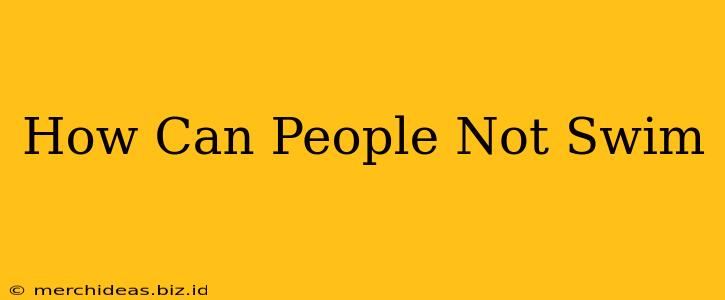How Can People Not Swim? Understanding Non-Swimmers
Many people assume everyone can swim, but the reality is that a significant portion of the global population lacks this essential life skill. This article explores the reasons why some people don't know how to swim, addressing the multifaceted factors contributing to this widespread phenomenon.
Fear and Trauma
One of the most significant barriers to learning to swim is fear of water. This fear, often called aquaphobia, can range from mild anxiety to a debilitating phobia that prevents even entering a pool or body of water. It can stem from:
- Negative childhood experiences: A near-drowning experience, a frightening incident in water, or even witnessing a water-related accident can leave lasting psychological scars that hinder the learning process.
- Lack of early exposure: Children who don't have access to swimming lessons or opportunities to play safely in water may develop a fear of the unknown.
- Inherited traits: Some people may be genetically predisposed to a heightened fear response related to water.
Overcoming this fear requires professional help. A qualified swimming instructor or therapist specializing in aquaphobia can use techniques to gradually desensitize individuals to water and build their confidence.
Physical Limitations and Disabilities
Certain physical conditions can make learning to swim incredibly challenging, or even impossible, for some individuals. These might include:
- Physical disabilities: Individuals with limited mobility, visual impairments, or other physical disabilities may face significant obstacles in learning the necessary skills and coordination. Adaptive swimming techniques and specialized instruction are crucial in these cases.
- Medical conditions: Conditions like epilepsy, heart conditions, or respiratory problems can pose significant safety risks and prevent participation in swimming lessons.
- Age-related limitations: While it's never too late to learn, older individuals may have physical limitations that make learning more difficult.
Socioeconomic Factors
Access to swimming lessons and facilities plays a substantial role in determining swimming ability. Many factors contribute to this disparity:
- Financial constraints: Swimming lessons can be expensive, making them inaccessible to low-income families.
- Geographic limitations: People living in areas without access to pools or other bodies of water have fewer opportunities to learn.
- Cultural barriers: Some cultures may not prioritize swimming as a life skill, leading to fewer opportunities for children to learn.
Lack of Opportunities and Education
The absence of formal swimming instruction significantly contributes to the inability to swim.
- Inadequate school programs: Many schools lack comprehensive swimming programs, leaving students without the opportunity to develop fundamental water safety skills.
- Limited access to qualified instructors: A shortage of qualified and experienced swimming instructors, particularly in underserved communities, restricts access to quality instruction.
Overcoming the Barriers: Promoting Water Safety and Inclusivity
Addressing the issue of non-swimmers requires a multi-pronged approach focused on increasing access to swimming lessons, addressing fear and trauma, and promoting water safety education for all. Initiatives should include:
- Subsidized swimming lessons: Providing affordable or free swimming lessons for low-income families.
- Adaptive swimming programs: Developing specialized programs for individuals with disabilities.
- Community-based water safety education: Implementing educational programs in schools and community centers.
- Addressing aquaphobia through therapy: Making mental health resources readily available for those struggling with fear of water.
Learning to swim is a valuable life skill that can save lives. By understanding the various reasons why people don't know how to swim, we can work toward more inclusive and accessible swimming programs that ensure everyone has the opportunity to learn this vital skill.
